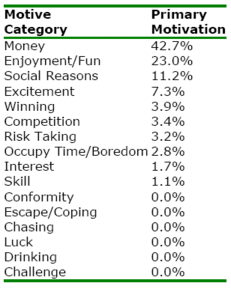College students represent a segment of our population that is particularly vulnerable to problem gambling. The lifetime prevalence of problem gambling among college students is estimated to be 5.6%, almost three times that found in the general adult population (1.9%, Shaffer & Hall, 2000). This week The WAGER reports on a study by Neighbors et al. (2002) that examined gambling motivation among college students.
Neighbors et al. recruited 184 college student gamblers (68% male, 70% Caucasian, mean age 19.4) enrolled in an introductory psychology course. Students completed the SOGS (Lesieur & Blume, 1987) and a questionnaire on gambling motivation. This measure asked students to list in rank order the top five reasons they gamble. Five coders independently classified each of the 766 reasons given into 16 motives that the researchers determined by an initial qualitative analysis of student responses. The researchers ultimately classified responses according to the majority of coders’ endorsements. For 7% of the responses, there was no majority or the response was too general to be categorized; these responses were excluded from the analyses. Table 1 displays the results for the primary motivations (i.e., those ranked first).
Table 1. Prevalence of Gambling Motives (Neighbors et al., 2002)
Over 42% of the students reported that they gambled primarily to make or win money. Enjoyment, social reasons, and excitement were also commonly cited reasons; collectively these three motives account for another 42% of the reasons given for gambling. Sixteen students (9.3%) were classified as level 2 gamblers and six students (3.5%) were classified as level 3 gamblers by the SOGS. The authors found no significant relationship between motives and SOGS scores.
One limitation is that this study used a convenience sample; convenience samples often do not represent the population from which they came. Therefore, these results might not generalize to the entire college population. For example, almost 60% of the students surveyed were freshman and are likely to be under the legal age for many gambling activities. Underage gamblers’ motivation for gambling might be different than their peers who are able to gamble legally. Further, the small number of problem and pathological gamblers make it difficult to determine and compare the motivational patterns of these groups to non-problem gamblers.
The authors also emphasized that the students might not be aware of all the motivational factors that influence their gambling; therefore, the results might be limited. Additionally, the researchers used a subjective process to generate motive categories; a slightly different clustering of motivations (e.g., combining the overlapping categories of “winning” and “competition’) or allotment of motivations might yield different results.
This study highlights the most common reasons reported by college students for gambling. Establishing the motivational factors for gambling is an important step in designing prevention efforts: by matching prevention strategies to motivations, it should be possible to improve the influence of prevention programs and reduce the incidence of gambling disorders among this population.
Comments on this article can be addressed to Rachel Kidman.
References
Lesieur, H. R., & Blume, S. B. (1987). The South Oaks gambling screen (SOGS): A new instrument for the identification of pathological gamblers. American Journal of Psychiatry, 144(9), 1184-1188.
Neighbors, C., Lostustter, T., Cronce, J., & Larimer, M. (2002). Exploring College Student Gambling Motivation. Journal of Gambling Studies, 18(4), 361
370.
Shaffer, H. J., & Hall, M. N. (2000). Updating and refining meta-analytic prevalence estimates of disordered gambling behavior in the United States and Canada. Boston: Division on Addictions, Harvard Medical School.





